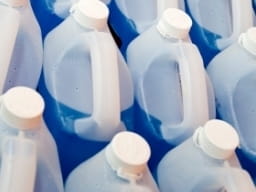Taste Changes Don't Stop Poisonings

The Bottom Line
Antifreeze is a sweet-tasting poison. Studies show that adding a bittering agent to antifreeze does not decrease poisonings or suicides with antifreeze.

The Full Story
It sounded like a good idea: make poisons taste really bad and children won't swallow them. Unfortunately, this seemingly smart idea just doesn't work.
Some states required that a very bitter substance be added to antifreeze, a sweet-tasting poison. The goal was to improve the outcome of poisonings, especially in children. Volunteer studies had indicated that people would swallow less of a bittered substance than of its original form. Studies looked at what happened before and after these bittering agents were introduced.
Contrary to expectations, the number of poisonings did not go down. The number of children who swallowed antifreeze was the same before and after the bitter formula was introduced. In comparing children who swallowed sweet-tasting antifreeze with children who swallowed bitter-tasting antifreeze, several findings stood out:
- Adding a bittering agent did not decrease the number of children who swallowed antifreeze.
- Both groups of children swallowed approximately the same amounts.
- There was no difference in the need for hospitalization or critical care treatment for those who swallowed this substance.
- There was no difference in the need for antidotes.
- There was no difference in how the children did medically.
- There were no deaths in either group.
In another study, researchers examined whether the outcome of suicides with antifreeze changed when a bitter substance was added. Again, the answer was "no". There was no change in the number of people who attempted suicide by drinking antifreeze. There was no difference in the amount that they swallowed, what kinds of medical treatment they needed, or medical outcome.
The substance used was denatonium benzoate, described in the Merck Index as one of the most bitter substances known to man. There have been no studies of its safety when swallowed by humans.The two studies cited above do not support a role for this chemical in reducing poisonings, unintentional or intentional. Nor do they support a role for legislating the addition of bittering agents in household products and chemicals as an attempt to reduce poisonings.
Keeping poisons safely out of reach of children and supervising them closely remain at the heart of poison prevention for children. A multi-faceted approach to suicide prevention is essential, but altering the taste of poisons does not appear to reduce the number of suicide attempts.
And remember, if someone gets into a product or substance that may be poison, get free, immediate, 24/7 help from the experts at Poison Control using webPOISONCONTROL®, the online tool, or by calling 1-800-222-1222.
Rose Ann Gould Soloway, RN, BSN, MSEd, DABAT emerita
Clinical Toxicologist
Poisoned?
Call 1-800-222-1222 or
Prevention Tips
Keeping poisons safely out of reach of children and supervising them closely remain at the heart of poison prevention for children. A multi-faceted approach to suicide prevention is essential, but altering the taste of poisons does not appear to reduce the number of suicide attempts.
This Really Happened
A 4-year-old girl swallowed an unknown quantity of antifreeze containing 41% ethylene glycol (EG) (a toxic alcohol that may cause coma, blood chemistry abnormalities, kidney failure and death). A high concentration of Bitrex® (denatonium benzoate, a bittering agent meant to discourage ingestion) in the product did not discourage the child from drinking an apparently potentially lethal amount of the antifreeze. One hour later, she was drowsy and limp. She was admitted to the hospital. EG poisoning was confirmed by highly abnormal blood chemistry studies as well as by the history and her symptoms. Seven hours after the ingestion, her blood studies worsened. She had metabolic acidosis (a disruption of the body's acid-base balance). She was treated with 4-methylpyrazole (more commonly known as fomepizole), an antidote that blocks the toxic byproducts of ethylene glycol breakdown in the body. Her metabolic acidosis improved after several hours. Her kidney function remained normal. She was able to be discharged on the 4th hospital day. Nine days later her physical examination was normal and she had no remaining complications of EG poisoning.
Reference: Harry P, Jobard E, Briand M, Caubet A, Turcant A. Ethylene glycol poisoning in a child treated with 4-Methylpyrazole. Pediatrics. 1998;102;e31. DOI: 10.1542/peds.102.3.e31
References
Poisoned?
Call 1-800-222-1222 or
Prevention Tips
Keeping poisons safely out of reach of children and supervising them closely remain at the heart of poison prevention for children. A multi-faceted approach to suicide prevention is essential, but altering the taste of poisons does not appear to reduce the number of suicide attempts.
This Really Happened
A 4-year-old girl swallowed an unknown quantity of antifreeze containing 41% ethylene glycol (EG) (a toxic alcohol that may cause coma, blood chemistry abnormalities, kidney failure and death). A high concentration of Bitrex® (denatonium benzoate, a bittering agent meant to discourage ingestion) in the product did not discourage the child from drinking an apparently potentially lethal amount of the antifreeze. One hour later, she was drowsy and limp. She was admitted to the hospital. EG poisoning was confirmed by highly abnormal blood chemistry studies as well as by the history and her symptoms. Seven hours after the ingestion, her blood studies worsened. She had metabolic acidosis (a disruption of the body's acid-base balance). She was treated with 4-methylpyrazole (more commonly known as fomepizole), an antidote that blocks the toxic byproducts of ethylene glycol breakdown in the body. Her metabolic acidosis improved after several hours. Her kidney function remained normal. She was able to be discharged on the 4th hospital day. Nine days later her physical examination was normal and she had no remaining complications of EG poisoning.
Reference: Harry P, Jobard E, Briand M, Caubet A, Turcant A. Ethylene glycol poisoning in a child treated with 4-Methylpyrazole. Pediatrics. 1998;102;e31. DOI: 10.1542/peds.102.3.e31
